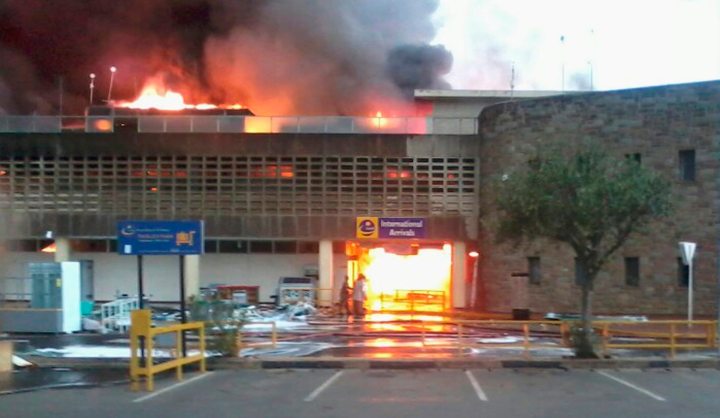Africa
The phoenix-like return of Nairobi’s international airport

When east and central Africa’s busiest airport burst into flames last month, it was just the latest in a series of disasters and scandals afflicting Jomo Kenyatta International. But from the ashes came a swift, professional response – and the promise of something new. African travellers, rejoice! By SIMON ALLISON.
Few shed tears when the international arrivals and departures terminal at Nairobi’s Jomo Kenyatta International Airport (JKIA) caught fire last month (thankfully no one was injured in the blaze). JKIA is an old and unloved airport, the scene of too many disaster stories of delayed flights, lost luggage and poor service. Its bare concrete walls and prison-slit windows have long gone out of fashion, and passengers have been known to get lost in the narrow, claustrophobia-inducing duty free corridor, a seemingly never-ending circle of shabby fixtures, dim lighting and identical shops.
And yet, when travelling within sub-Saharan Africa, there’s no way to avoid JKIA. Along with OR Tambo in Johannesburg and Bole International in Addis Ababa, it is one of the continent’s three main aviation hubs, and the busiest airport in east and central Africa. Originally built by the British in 1958 to handle just 2-million passengers per year, it now deals with more than triple that – a testament both to Kenya’s enduring attraction for tourists, and Kenya Airways’ success in cornering a large chunk of the African market.
A couple of incidents in the last couple of months revealed that JKIA’s problems went beyond the superficial. First, the company that runs the duty free was evicted after a nasty legal dispute with the Kenya Airports Authority, the parastatal that manages JKIA. This was in flagrant violation of a court order which said that nothing should change until the case was settled in court, and media reports suggest the matter was handled completely unprofessionally, with tenants describing “gangs of youths” preventing them from accessing their shops. Widespread looting was also reported.
Then there was the fire. On 7 August, a couple of wires in a power distribution box overheated and sparked. The flames spread quickly and emergency services were slow to respond. When they did, they were woefully underprepared. Some fire trucks weren’t filled with water, while others lacked drivers. On the scene, emergency responders were spotted trying to take money from damaged ATMs and foreign exchange bureaux. That no one was injured in the fire was simply good fortune. As for the terminal where the fire broke out, it was completely gutted.
For the airport, and for Kenyan airways, it looked like a disaster. The runway was shutdown, flights were cancelled, and no one knew when the airport would be up and running again. There were fears for the immediate future of Kenya’s economy, reliant on the twin pillars of tourism and flower exports, both of which depend on a functioning international airport.
But then something remarkable happened. As the Economist observed: “When a big part of Nairobi’s Jomo Kenyatta international airport was gutted by a fire in early August it was widely expected to wreak havoc on Kenya’s vital tourism industry. Instead, it has become a model of the country’s talent for makeshift solutions.”
Within a day, a huge tent was put up to act as a makeshift terminal. Within three weeks, this had been replaced by a temporary terminal in what used to be the main parking garage, with a Chinese firm completing the conversion for just $1-million (not that the government paid. This was a “gift” from the company). By December, a new terminal – Terminal 4 – will be complete, which will house international arrivals and departures until the really big expansion project gets off the ground.
Before the fire, this project was more wishful thinking than anything else. Now, however, rebuilding has become more urgent, and there’s plenty of political impetus to get it done. When it is complete, the new runway and new terminal will increase the airport’s capacity to 40-million passengers per year, more than enough to handle Kenya Airways planned doubling of its fleet (to 80 aircraft).
Transport minister Michael Kamau confirmed this week that the government had sought financing for the project, estimated to cost $653-million, and received three full funding offers from banks. More encouragingly, none of these offers required any kind of government guarantee, meaning the banks are confident they will recoup their loans.
All too often, creating something new – and better – requires the destruction of that which came before. Kenyan authorities may not have had much say in when the old international terminal was destroyed, although their lack of preparedness certainly contributed. They are in charge, however, of making sure that whatever does replace it is an improvement on the original, and that it happens as quickly as possible. So far, the signs have been encouraging on both fronts. For the many travellers who pass through JKIA, this can only be good news. DM
Kenya secures funds for airport expansion, on VOA
Photo: The arrival lounge of Jomo Kenyatta International Airport is seen in flames, in Kenya’s capital Nairobi, August 7, 2013. REUTERS/Stringer


















 Become an Insider
Become an Insider